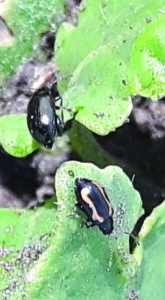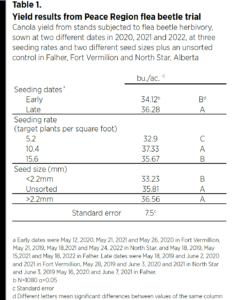Steps to reduce flea beetle risk
KEY RESULT:
This study based in the Peace River region of Alberta showed that later seeding, higher plant counts and larger seeds reduce flea beetle risk to canola yield.
PROJECT TITLE, PRINCIPAL INVESTIGATOR:
“Evaluating the effect of canola seeding rate and seed size seeded into wheat stubble on flea beetle damage and population,” María Angélica Ouellette, North Peace Applied Research Association
FUNDING:
Alberta Canola
PUBLISHED ARTICLES:
Read the full report in the Research Database at AlbertaCanola.com.
This study aimed to evaluate the impact of seeding rate, seed size and seeding date on flea beetle damage to canola foliage. It measured the impacts on the three major flea beetle species: crucifer (Phyllotetra cruciferae Goeze), striped (Phyllotetra striolata Fabricius) and hop (Psylliodes punctulate Melscheimer).
Researchers ran trials in 2020, 2021 and 2022 at three northern Alberta sites: the North Peace Applied Research Association facility in North Star, the Mackenzie Applied Research Association in Fort Vermillion and the Smoky Applied Research and Demonstration Association in Fahler.
The experiment was a four replicate, split plot analysis with three treatments:
- Seeding rate. Three rates were control (target of 10.4 plants per square foot), half rate (target of 5.2 plants per square foot) and 1.5x rate (target of 15.6 plants per square foot)
- Seed size. Sizes were classified as small (<2.2mm diameter), large (>2.2mm) as well as an unsorted control with both sizes. Researchers ran the same seed lot over a sieve to separate the sizes. Note that seed was treated with fungicide only. Researchers did not want insecticide seed treatment to deter actual numbers of flea beetles and limit the results.
- Seeding date. The goal was to use an early treatment seeded between late April and early May and a normal treatment seeded the second to third week of May. Weather conditions, such as frequent precipitation events, did not allow researchers to hit these targets. Hence early seeding was the second to third week of May and late dates were the fourth week of May and first week of June.
Researchers conducted flea beetle counts and leaf damage assessments every three days until canola stands reached the four-leaf stage.
Results

At later seeding dates, canola stand counts, canola yield and total number of flea beetles were greater. Overall flea beetle numbers may have in27creased in plots seeded later because more canola plants are available for feeding. Despite the higher flea beetle numbers and damage, higher yield for late-seeded plots is likely due to warmer temperatures that facilitate faster growth and plant development. These plants therefore had more tolerance to flea beetle feeding.
Control seeding rates produced more yield than both higher and lower seeding rates.
Seeds greater than 2.2mm and unsorted seed had higher yields despite having more striped flea beetles than plots with smaller seeds.
With the findings from their experiment, researchers demonstrate that stand count, leaf damage and total flea beetle number of individuals are impacted mostly by seeding date and rate, and to a certain length, seed size. On the other hand, seeding rate, date and seed size impacted canola yield and to some extent some flea beetle species in comparison to others.
The general conclusion is that later seeding, normal recommended plant counts and larger seeds reduce flea beetle risk to canola yield.






